The mighty Stephansdom marks the heart of Austria’s capital. Even today, the cathedral’s Gothic south tower, completed in the mid-fifteenth century, still dominates the skyline.
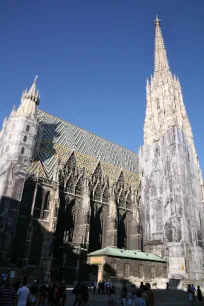
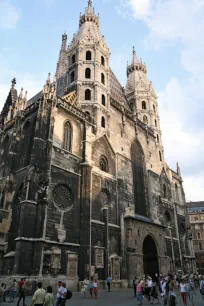
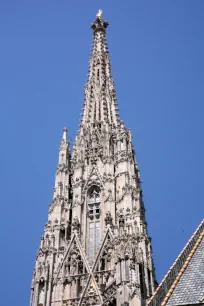
History
The first church built at this site possibly dates back to the fourth century, but the oldest parts of today’s St. Stephen’s Cathedral – the towers of the front facade – go back to the thirteenth century, when the existing Romanesque church from the twelfth century was expanded. The towers were all that remained after a fire destroyed the church in 1258. Just five years later, the church was rebuilt, now with a larger nave, and the two surviving towers were incorporated in the new building.
Much of what we see today stems from an expansion that was started in 1304 by King Albert I. His grandson, Rudolf IV the Founder, laid the first stone for yet another expansion in 1359, which would bring the church to its current size. Work continued throughout the fourteenth and fifteenth century. The south tower and the nave were completed in 1455, but construction of the north tower stalled in 1511, shortly after the church was promoted to the status of cathedral in 1469.
Exterior
The west facade of the cathedral, facing Stephansplatz, is the only surviving part of the thirteenth century Romanesque church. The two towers are known as the Heidentürme (Pagan towers) – possibly because material from Roman buildings were used to construct the towers. Between the towers is the main entrance to the cathedral via the Riesentor, (Giant’s Gate), a monumental pointed arch. The large window above the Riesentor is from a later era.
The crowning piece of the Stephansdom is the south tower, ironically nicknamed Steffl (little Stephen). The tall Gothic tower’s spire reaches a height of 137 meters (450 feet) and even today it towers high over Vienna’s inner city. A staircase, 418 steps long, leads from the sacristy to the top.
Opposite the Steffl is the unfinished north tower. By the time work on the tower was halted in 1511 the Gothic style had fallen out of favor and the new, fashionable Renaissance style was used to decorate the truncated tower with a belfry in 1556. The tower houses the Pummerin bell, originally cast in 1711 from the metal of captured Turkish cannons. The bell is the largest in the Stephansdom, and even one of the largest in Europe.
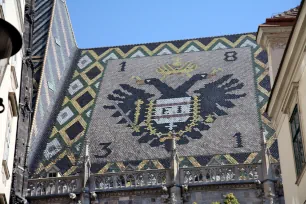
The roof of the cathedral is decorated with more than two hundred thousand glazed tiles. They form enormous mosaics depicting a double-headed eagle (symbol of the Holy Roman Empire) and the coats of arms of Vienna and Austria.
Interior
The nave of the Stephansdom is 108 meters (354 feet) long and impresses thanks to its Gothic vaulted ceiling, which reaches a height of about 27 meters (88 feet).
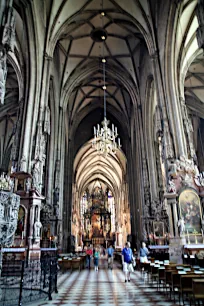
The stone Gothic pulpit, sculpted in 1514 by master stonemason Anton Pilgram is most likely to first catch the attention of visitors. The pulpit is beautifully adorned with statues of animals and saints. Pilgram himself makes a cameo, he looks out of a window at the foot of the stairs.
While the cathedral is mostly Gothic in style, the high altar is clearly Baroque. The marble and stone altar, created by Johann Jakob Pock, shows statues of four saints. The central painting, by Johann’s brother Tobias, shows the martyrdom of St. Stephen. In the Virgin’s Choir, to the left of the high altar, is the late Gothic Wiener Neustädter Altar, originally created in 1447 for a cloister but moved to the Stephansdom in the late nineteenth century. The panels of the winged altarpiece show saints and scenes from the lives of Jesus and Mary.
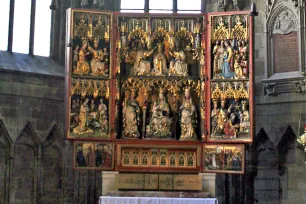
A majestic red marble tomb in the Apostles’ Choir to the right of the high altar contains the remains of Emperor Frederick III. The tomb, designed by Nicolaus Gerhaert van Leyden and built between 1467 and 1513, is decorated in Renaissance style with several hundred statues and thirty-two coats of arms.
Stairs in the north transept lead to the catacombs, where the bones of thousands of locals are stocked. A more dignified final resting place has been reserved for some of the early Habsburg rulers, including Emperor Rudolf IV. Later Habsburgs were buried in the Kaisergruft.

